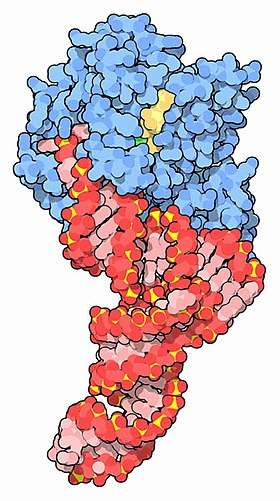Elongation factor
Elongation factors are a set of proteins that function at the ribosome, during protein synthesis, to facilitate translational elongation from the formation of the first to the last peptide bond of a growing polypeptide.[1] Bacteria and eukaryotes use elongation factors that are largely homologous to each other, but with distinct structures and different research nomenclatures.[2]

Elongation is the most rapid step in translation.[3] In bacteria, it proceeds at a rate of 15 to 20 amino acids added per second (about 45-60 nucleotides per second). In eukaryotes the rate is about two amino acids per second (about 6 nucleotides read per second). Elongation factors play a role in orchestrating the events of this process, and in ensuring the high accuracy translation at these speeds.
Nomenclature of homologous EFs
| Bacterial | Eukaryotic/Archaeal | Function |
|---|---|---|
| EF-Tu | eEF-1 subunit α[2] | mediates the entry of the aminoacyl tRNA into a free site of the ribosome.[4] |
| EF-Ts | eEF-1 subunit βγ[2] | serves as the guanine nucleotide exchange factor for EF-Tu, catalyzing the release of GDP from EF-Tu.[2] |
| EF-G | eEF-2 | catalyzes the translocation of the tRNA and mRNA down the ribosome at the end of each round of polypeptide elongation. Causes large conformation changes.[5] |
| EF-P | EIF5A | possibly stimulates formation of peptide bonds and resolves stalls.[6] |
| Note that EIF5A, the archaeal and eukaryotic homolog to EF-P, was named as an initiation factor but now considered an elongation factor as well.[6] | ||
In addition to their cytoplasmic machinery, eukaryotic mitochondria and plastids have their own translation machinery, each with their own set of bacterial-type elongation factors.[7][8] In humans, they include TUFM, TSFM, GFM1, GFM2.
In bacteria, selenocysteinyl-tRNA requires a special elongation factor SelB (P14081) related to EF-Tu. A few homologs are also found in archaea, but the functions are unknown.[9]
As a target
Elongation factors are targets for the toxins of some pathogens. For instance, Corynebacterium diphtheriae produces its toxin, which alters protein function in the host by inactivating elongation factor (EF-2). This results in the pathology and symptoms associated with Diphtheria. Likewise, Pseudomonas aeruginosa exotoxin A inactivates EF-2.[10]
References
- Parker, J. (2001). "Elongation Factors; Translation". Encyclopedia of Genetics: 610–611. doi:10.1006/rwgn.2001.0402. ISBN 9780122270802.
- Sasikumar, Arjun N.; Perez, Winder B.; Kinzy, Terri Goss (July 2012). "The Many Roles of the Eukaryotic Elongation Factor 1 Complex". Wiley Interdisciplinary Reviews. RNA. 3 (4): 543–555. doi:10.1002/wrna.1118. ISSN 1757-7004. PMC 3374885. PMID 22555874.
- Prabhakar, Arjun; Choi, Junhong; Wang, Jinfan; Petrov, Alexey; Puglisi, Joseph D. (July 2017). "Dynamic basis of fidelity and speed in translation: Coordinated multistep mechanisms of elongation and termination". Protein Science. 26 (7): 1352–1362. doi:10.1002/pro.3190. ISSN 0961-8368. PMC 5477533. PMID 28480640.
- Weijland A, Harmark K, Cool RH, Anborgh PH, Parmeggiani A (March 1992). "Elongation factor Tu: a molecular switch in protein biosynthesis". Molecular Microbiology. 6 (6): 683–8. doi:10.1111/j.1365-2958.1992.tb01516.x. PMID 1573997.
- Jørgensen, R; Ortiz, PA; Carr-Schmid, A; Nissen, P; Kinzy, TG; Andersen, GR (May 2003). "Two crystal structures demonstrate large conformational changes in the eukaryotic ribosomal translocase". Nature Structural Biology. 10 (5): 379–85. doi:10.1038/nsb923. PMID 12692531.
- Rossi, D; Kuroshu, R; Zanelli, CF; Valentini, SR (2013). "eIF5A and EF-P: two unique translation factors are now traveling the same road". Wiley Interdisciplinary Reviews. RNA. 5 (2): 209–22. doi:10.1002/wrna.1211. PMID 24402910.
- Manuell, Andrea L; Quispe, Joel; Mayfield, Stephen P; Petsko, Gregory A (7 August 2007). "Structure of the Chloroplast Ribosome: Novel Domains for Translation Regulation". PLoS Biology. 5 (8): e209. doi:10.1371/journal.pbio.0050209. PMC 1939882. PMID 17683199.
- G C Atkinson; S L Baldauf (2011). "Evolution of elongation factor G and the origins of mitochondrial and chloroplast forms". Molecular Biology and Evolution. 28 (3): 1281–92. doi:10.1093/molbev/msq316. PMID 21097998.
- Atkinson, Gemma C; Hauryliuk, Vasili; Tenson, Tanel (21 January 2011). "An ancient family of SelB elongation factor-like proteins with a broad but disjunct distribution across archaea". BMC Evolutionary Biology. 11 (1). doi:10.1186/1471-2148-11-22.
- Lee H, Iglewski WJ (1984). "Cellular ADP-ribosyltransferase with the same mechanism of action as diphtheria toxin and Pseudomonas toxin A". Proc. Natl. Acad. Sci. U.S.A. 81 (9): 2703–7. Bibcode:1984PNAS...81.2703L. doi:10.1073/pnas.81.9.2703. PMC 345138. PMID 6326138.
Further reading
- Alberts, B. et al. (2002). Molecular Biology of the Cell, 4th ed. New York: Garland Science. ISBN 0-8153-3218-1.
- Berg, J. M. et al. (2002). Biochemistry, 5th ed. New York: W.H. Freeman and Company. ISBN 0-7167-3051-0.
- Singh, B. D. (2002). Fundamentals of Genetics, New Delhi, India: Kalyani Publishers. ISBN 81-7663-109-4.
External links
- nobelprize.org Explaining the function of eukaryotic elongation factors
- Elongation+Factor at the US National Library of Medicine Medical Subject Headings (MeSH)
- Peptide+Elongation+Factor+G at the US National Library of Medicine Medical Subject Headings (MeSH)
- Peptide+Elongation+Factor+Tu at the US National Library of Medicine Medical Subject Headings (MeSH)
- EC 3.6.5.3